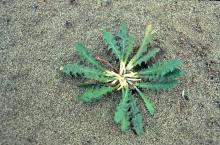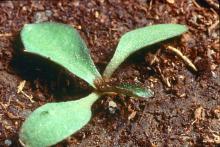2,4-D or MCPA
Rate 2 lb ae/A
Time Apply to rosettes in the spring immediately before or during bolting.
Remarks 2,4-D inhibits further aboveground growth but will not prevent new plant development from root buds.
Caution Re-treatment is important.
Site of action (both) Group 4: synthetic auxin
Chemical family (both) phenoxy acetic acid
aminocyclopyrachlor + chlorsulfuron (Perspective)
Rate 1.8 to 3.2 oz/A aminocyclopyrachlor + 0.7 to 1.3 oz/A chlorsulfuron (4.5 to 8 oz/A of product)
Time Apply to actively growing plants in spring.
Remarks Adjuvants can be used; these include methylated seed oils 0.5 to 1% v/v, nonionic surfactants at 0.25 to 1% v/v, and crop oil concentrates at 1% v/v. Can be applied using an invert emulsion rather than water.
Caution Even low rates can kill nontarget tree and shrub species, so avoid application within a distance equal to the tree height of the sensitive species. Do not allow spray to drift off target. Can injure several grass species including bromes, as well as basin wildrye.
Site of action (aminocyclopyrachlor) Group 4: Synthetic auxin; (chlorsulfuron) Group 2: ALS inhibitor
Chemical family (aminocyclopyrachlor) Pyrimidine carboxylic acid; (chlorsulfuron) Sulfonylurea
aminopyralid (Milestone)
Rate 1.75 oz ae/A (7 fl oz/A Milestone)
Time Spring or fall when rosettes are present.
Remarks A nonionic surfactant at 1 to 2 quarts per 100 gal of spray enhances control under adverse environmental conditions.
Caution Do not allow drift to desirable vegetation. Many forbs (desirable broadleaf plants) can be seriously injured or killed. Do not exceed 7 fl oz/A Milestone per year.
Site of action Group 4: synthetic auxin
Chemical family Pyridine
clopyralid (Transline or Stinger)
Rate 0.25 to 0.375 lb ae/A (0.66 to 1 pint/A)
Time Apply to rosette in fall or up to early bolting in spring.
Remarks Consult labels for specific site registrations.
Caution Product will injure or kill sensitive broadleaf forages. Consult label for crop rotation restrictions before using. Several crops may be injured several years after application.
Site of action Group 4: synthetic auxin
Chemical family Pyridine
picloram (Tordon)
Rate 1 lb ae/A
Time Apply from late fall to early spring. For best results, apply just before or during bolting.
Remarks Rush skeletonweed can reduce crop yields by as much as 70%, so it is important to treat small infestations. Picloram is the most effective treatment available. Re-treatment is necessary.
Caution Most formulations are restricted-use herbicides. Do not contaminate water. Potatoes, beans, and many other broadleaf crops are sensitive to picloram; do not use in diversified crop areas.
Site of action Group 4: synthetic auxin
Chemical family Pyridine




